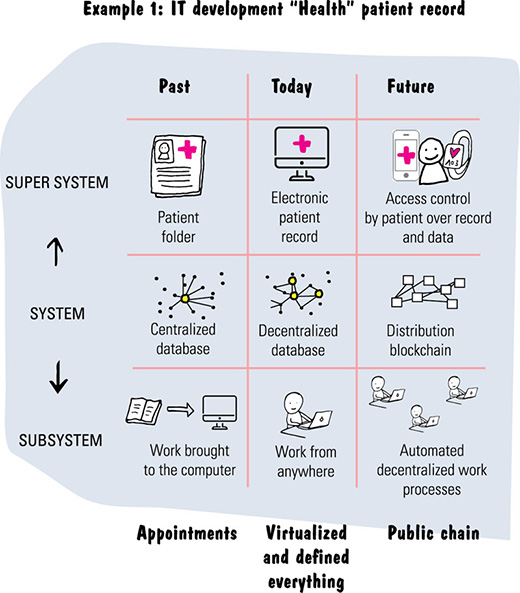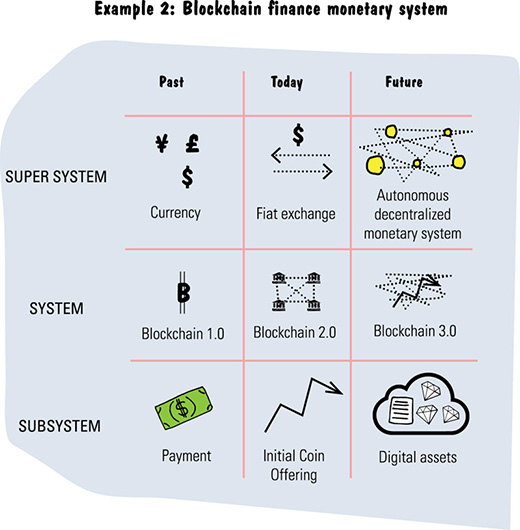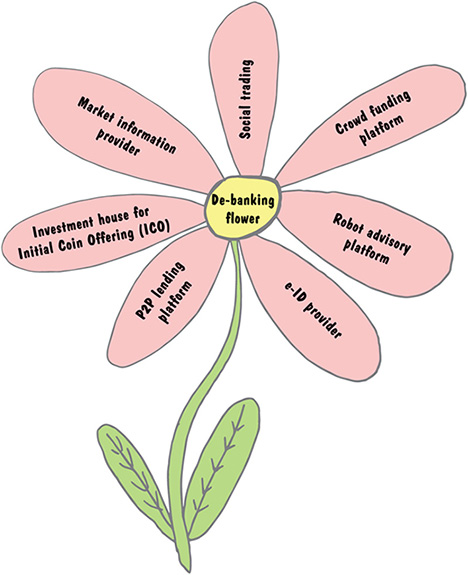1.6 How to find the right focus
By way of introduction, we already pointed out in Chapter 1.2 that the hardest thing is to determine the point of view (in short: PoV). Therefore we would like to introduce tools and methods that make this step easier.
Peter, Lilly, and Marc are frequently faced with the challenge of having to find a solution not only for one group of people but also one that is relevant to a multitude of different users or customers. In such cases, it is decisive to assume a 360° view.
In principle, empathy with a potential user is an important integral part when preparing the ideation phase; it also reminds us of our limits. Empathy is vital not only for selecting the right community but also for the way in which we pose the right questions during this phase. The questions should prompt interviewees to put themselves in different situations and consider them from different points of view.
What might the sequence for this look like? It starts with formulating the problem; then comes the definition of the relevant points of view, which ultimately leads to the questions being answered within the set framework.

Up to now, we have concentrated on developing a product for a single group of people or users and emphasized how important empathy is. Now we want to go one step further and solve a problem for a wide range of users. The concrete procedure is described on page 81.
In our experience, the following approach is suitable for obtaining a good PoV.
A) Analyze information
- Collection, interpretation, and analysis of all information.
- Summary and consolidation of key findings into insights.
B) Infer insights
- Summarize the 10 most important insights.
- Infer the design principles or problem clusters from it.
C) Formulate possible questions
- Mark possible key themes or questions (e.g., dot voting on insights and principles).
- Choose three thematic areas and formulate the question.
D) Specify questions
- Present, discuss, and select a question.
- Refine and improve the question.


We have had good experience with a 360° view of a question.
Let’s take a need of our persona, Lilly. Lilly wants to marry Jonny. They plan their wedding party together. They do not yet know how the wedding party should look. So the problem statement is:
Lilly and Jonny don’t know yet how their wedding party should look.
The question derived from this would be:
“What should Lilly and Jonny’s wedding party look like?”
Based on this, the stakeholders and points of view are defined:
“Suppliers and the budget, for instance, are important when you plan a wedding.”

Before we search for specific ideas, the ideation phase must be well prepared. As we have learned in the previous chapters, we are dealing with the divergent phase here, meaning nothing else than that the horizon is broadened and new ideas are searched for. To allow for this, we consider the problem from as many different perspectives as possible (i.e., from a 360° view), starting with the question.
As shown by way of example in the table, the points of view range from “money” to “age.” A rough differentiation is made between the stakeholders and other points of view. Of course, the number of possible points of view is infinite—hence the selection presented here is only an example. Note that if a stakeholder map exists (see Chapter 3.4, p. 258), it can also be used as a starting point.
Back to our actual problem statement: the wedding party. We want to identify the relevant points of view and reflect upon the question of which stakeholders and which other points of view might be relevant for the question of Lilly and Jonny. As shown in the table, it is useful to define the points of view and their intentions. This makes it easier to share the points of view with other participants.
Stakeholders |
|
Customers |
|
Partners |
|
Employees |
|
Government institutions |
|
Residents |
|
Competition |
|
Other points of view |
|
Time |
|
Money |
|
Imaginary world |
|
Age |
|
Culture |
|
Geopolitics |
|
Time pressure |
|
The wedding party points of view |
Explanation of the point of view |
The couple |
Lilly and Jonny stand at the center of the question |
The parents of the couple |
They are very close to their children |
The witnesses to the marriage |
They are close friends of the couple |
Children |
Many families with children are invited |
Seniors |
Many seniors are invited |
Money: With a lot of money |
So dreams can be formulated |
Money: Without money |
So the little things that cost nothing but give a great deal won’t be forgotten |
On another planet: on Venus, the planet of love |
For some kitsch and utopian fantasies |
In another culture: in the family of the Russian Tsar |
Inspiration from other cultures |
At another time: in the Middle Ages |
For great down-to-earthiness |
Reverse point of view |
To find out what the worst scenario would be |
After Lilly and Jonny’s point of view has been defined, a question should be formulated for every point of view. The question has the aim of enabling the potential friends, whom the couple will ask for advice, to take the said perspective and force them to answer the question from this point of view.
The questions for the ideation phase are often very broad. Lilly and Jonny won’t organize a workshop in their case, but they will probably collect answers during a shared dinner with their friends or via social media/e-mail. For a “working environment,” a physical workshop is advisable because creativity might suffer in a digital workshop, although feedback can be collected quickly in the latter.
To forestall respondents’ expressing only those ideas the couple is willing to hear, some of the ideation should be done on an anonymous basis, such as in writing or by means of an online tool. Anonymity is not absolutely necessary for collecting great ideas—after all, it’s fun to talk about things that are pleasing. But if you want to know what might bother people, anonymity is a must. To the question of “What would be the worst wedding party?” some of Lilly and Jonny’s friends responded they would fear having to sit at the same table with the same people all night long. Some friends are horrified at having to wear a suit all day long. Many families would like to stay overnight locally but cannot afford an expensive hotel.
The wedding party points of view |
Questions |
The couple |
What does the couple wish for the wedding party? |
The parents of the couple |
What do the parents of the couple wish for the wedding party? |
The witnesses to the marriage |
What do the witnesses wish for the wedding party? |
Children |
What do children wish for a wedding party? |
Seniors |
What do seniors wish for a wedding party? |
Planet Venus |
What would a wedding party on Venus look like? |
In the family of the Russian Tsar? |
What would a wedding party in the family of the Russian Tsar look like? |
In the Middle Ages? |
What did a wedding party in medieval times look like? |
Reverse point of view |
What would be the worst wedding party? |

There are countless methods for adding structure to the insights: Venn diagrams, mind maps, system maps, cluster analyses, customer journeys, and so forth.
The 9-window tool is a simple method for analyzing potential application cases and customer needs. In so doing, the product or service is more closely examined in the dimensions of “system” and “time.”
“System” refers to the structure of a product or service, including its entire environment. It invites you to zoom in to the product/service (subsystem) or to consider the super system (zoom out).
In the dimension of “time,” we vary the temporal consideration and focus on what happened in the past or might happen in the future. This approach helps us overcome barriers and see the product or digital service from a different point of view.
With the 9-window tool, Marc can structure his business idea about the theme of “patient record”


Jonny, who predicts that the banking landscape will change in the way they lend money, can transmit the effects of various blockchain evolution levels to the respective subsystems and super systems (example 2).

Frequently, the many elements are prioritized, such as by means of scoring. The elements with the highest score are pursued and one or several are chosen for the PoV.
A daisy map can be used to depict the most important elements. Its advantage is that the most important items are highlighted, so it’s not always the top item that is automatically seen as the most important. All five to eight flower petals are equal, as it were.

As we could see from the example of Lilly and Jonny’s wedding, the PoVs serve mainly to collect, structure, and weight all insights so as to find the relevant points. They also help us identify contradictions and determine the priorities for the next iterations. This is referred to as synthesis.
Synthesis is about finding the important needs and patterns of users, including those that were undiscovered up to now. The result of our synthesis is one condensed sentence, the PoV, which determines the question for the coming ideation phase. We will return to the topic of the synthesis in this expert tip because it poses a great challenge for many design thinking teams.
Every PoV sentence is a starting point that will be adapted in the next iteration lap.
- We recognize patterns in the needs of users.
- We see opportunities where others see problems.
- We understand the needs of our customers at all levels.
- We provide clarity about assumptions and hypotheses.
- We immerse ourselves in systems and make them tangible.
- We consolidate information and interpret it.
- We understand findings and emphasize the most important insights.
- We create the starting point and focus on the PoV for the next ideation.

We recommend formulating the PoV in a catchy sentence. Use various formulations. Try and test which variant is best for you, the team, and the situation.

Approach |
PoV sentence/fill-in-the-blank text |
How might we |
How might we . . . e.g., in the form: How might we help [the user, customer] to achieve [a certain goal]? Or: How many ways are there to achieve [a certain target] for [the user]? Example: How might we help patients keep their health records safe and share them with a doctor at a given time? |
Stanford PoV |
[User] needs to [need] because [surprising insight]. Or: [Who] wants [what] for [need fulfillment] because [motivation] . . . Example: The patient must have the data sovereignty for his health data because he wants to avoid abuse. |
Agile methods User stories |
As a [role/persona] (“who”) I would like to [action, destination, wish] (“what”), in order to achieve [benefit] (“why”). |